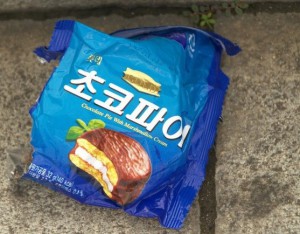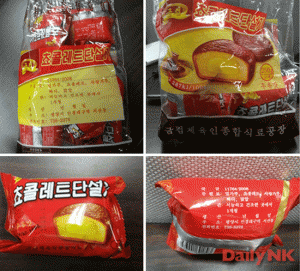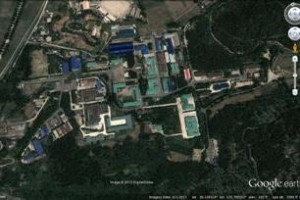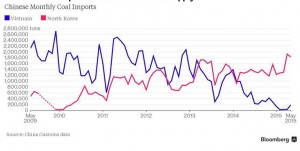
Pictured above (Source here): A Choco Pie wrapper in Pyongyang (October 2014)
UPDATE 6 (2015-7-14): The Daily NK reports that the DPRK’s ‘Choco Pie’ knock-off falls far short:
Daily NK has obtained a North Korean snack rolled out to squash demand for a popular South Korean treat that had first become a sensation among factory workers in the inter-Korean industrial complex and spread across the country. Known as ‘Chocolate Danseolgi,’ the snack displays a striking resemblance with the much-loved South Korean ‘Choco Pie’.
The new treat is said to have been produced to cut off fantasies about the capitalist world its workers may harbor.

Starting last month, North Korea has been providing its Kaesong factory workers with ‘Danseolgi’, according to a source who has ties with the North and passed on the new snack to Daily NK on the condition of anonymity. This comes after Pyongyang banned supplies of the famed ‘Choco Pie’ within the industrial complex last year, as they were being sold by the workers on the black market for good returns and gaining greater popularity across the country.
The South Korean ‘Choco Pie’ snack was first introduced to Kaesong workers in 2006. Due to its soaring popularity, many had come to develop a sense of curiosity or fantasies about the South, the source said. Seeing the chocolate cake snack with marshmallow filling win over so much love, Pyongyang set out to create an alternative in the hopes of choking off demand.
Last year, after banning ‘Choco Pie’ supplies, the North tried to force South Korean firms to provide its factory workers with a home-grown chocolate double-layered cake snack, and this year in March, it even rolled out a chocolate coated rice cake treat also similar to an existing South Korean product.
Despite these efforts, local goods have failed to take off, as Kaesong workers are already acquainted with tastes from South Korea and are only eating the ‘Danseolgi’ as they have no other choice, according to the source.
The treat is one of the “latest products” put out for Kaesong workers. “It was smuggled out of the country by way of a North Korean trader in the Rason Economic Special Zone who works with Chinese traders,” she explained.
“Currently in the North, the ‘Chocolate Danseolgi’ is being distributed to workers as supplies, and they’re not sold on North Korea’s regular markets,” she asserted. Every last ingredient used to make the snack, from the butter to the chocolate, is imported from China.
Predictably, Kaesong workers invariably far prefer the taste of the original chocolate snack from South Korea, the source said, adding, “North Korea will never be able to produce the South’s Choco Pie.”
One of Daily NK’s reporters who tried out the North Korean ‘Danseolgi’ described the snack as “decidedly lacking in chocolate flavor ” and “being overwhelmingly pungent of butter.” The wrapper claims to include marshmallow in the product, but our taste tester reported any semblance of its texture to be nonexistent and noted that the cake itself is incredibly prone to crumbling.
UPDATE 5 (2015-6-9): DPRK asks that all South Korean food served in the KIC be replaced by North Korean substitutes. According to Voice of America:
North Korea has asked South Korean businesses at the Kaesong industrial complex to replace all foodstuffs given to its workers at the inter-Korean park with North Korea-made products.
A representative of the South Korean businesses, who visited the complex Tuesday, told VOA’s Korean Service that South Korean companies began distributing North Korean substitutes for popular South Korean food supplies to the North Korean workers as early as March. Almost all South Korea-made food products have now been replaced with North Korean products.
Choco Pie, a popular South Korean snack cake, also has been replaced with a similar North Korea-made sweet. The chocolate covered cake with marshmallow filling has become one of the most popular items in the North’s black markets. Other North Korea-made foodstuffs given to the workers include instant noodles with chicken broth and condiments.
In an attempt to keep South Korean foodstuffs from the complex, the North is imposing an additional business tax on the companies for bringing in South Korea-made products. About 50 South Korean businesses supplying food for the complex face bankruptcy, according to representatives of the South Korean businesses.
Some business owners have expressed concern about the quality of North Korean foodstuffs. One representative said some workers are suffering from food poisoning after the switch.
A South Korean official who asked to remain anonymous told VOA the North Korean move is aimed at blocking the flow of South Korean products into the North and earning foreign currency.
South Korean companies have been providing about $60 per month in snacks to each North Korean worker. With approximately 53,000 workers at the complex, Pyongyang can now garner up to $3 million every month from the snack sales.
UPDATE 4 (2014-9-24): According to the Daily NK, workers in the KIC are receiving a different dessert than the Choco Pie now. Also, the Kumunsan Company is producing substitute goods, and they are winning over consumers:
[…] the once popular South Korean snack Choco Pie is seeing a decline in its asking price. In June, Pyongyang demanded that South Korean companies at the industrial complex stop distributing Choco Pies to workers there, as officials had found it problematic that North Korean workers were saving the snacks and selling them in the markets. More recently, the northern workers have been receiving Chaltteok Pie (찰떡) [a chocolate covered rice cake from the South], individually packaged coffee, yulmucha (율무차)[grainy tea made with Job’s Tears], and candy bars.
“In Pyongyang, at the ‘Geumeunsan Trade Company,’ (금운산, Kumunsan Trade Corporation) they have been baking bread for about a year,” the source said, adding, “Of all the different kinds of bread, the most popular are the ones with butter inside, and they are less than 1000 KPW– much cheaper than Choco Pie.”
The trade company is an affiliate of the Military Mobilization Department [Military Manpower Administration in South Korea], which deals with the procurement of military supplies among its many functions. They either directly import the goods or obtain them from military factories in various locations across the country, and oversee the manufacturing of military equipment and machinery.
Geumeunsan Trade Company maintains branches in multiple areas, including Rasun and Cheongjin, and the office in Pyongyang imports ingredients such as flour, sugar, and cooking oil directly from China. According to the source, the raw material prices are cheaper than in the North’s markets, and the products taste good, allowing it to monopolize the confectionery market there.
“The company has brought in foreign equipment and technology, putting it ahead of the South’s Choco Pie in price and taste,” he said, concluding, “This is why with the introduction of these different breads in Pyongyang, the price of Choco Pie [from the South] has dropped to 500 KPW from 1,200 KPW.”
See also this story in Radio Free Asia.
Read the full story here:
Kaesong Goods Fetch Highest Market Prices
Daily NK
Seol Song Ah
2014-9-24
UPDATE 3 (2014-7-1): Media reports claim that the DPRK has banned the use/possession of Choco Pies in the Kaesong Industrial Complex. According to the Washington Post:
By some estimates, as many as 2.5 million Choco Pies were traded monthly — though it’s unclear who exactly was so assiduously following Choco Pie markets.
Regardless of its volume, the trade will now surely be shrinking.
According to recent reports in the South Korean press, North Korean authorities have now banned the South Korean-produced Choco Pie at the Kaesong Industrial Complex following a lengthy crackdown on the chocolate treat that has made it scarce in Pyongyang.
Before, workers could pocket as many as 20 pies every night of work. But now, South Korean factory staff said they’ll instead get sausages, instant noodles, powdered coffee or chocolate bars as a bonus.
More information here and here.
UPDATE 2 (2013-9-20): Is the DPRK manufacturing a counterfeit Choc Pie? According to the Daily NK:

Pictured Above: Ryongsong Foodstuff Factory, Ryongsong District, Pyongyang (Google Earth)
The price of a North Korean own-brand “Choco Pie” fell to just 500 won in domestic markets following news that the Kaesong Industrial Complex (KIC) was to reopen, Daily NK has learned. The local version of the chocolate snack, which is made by Orion in South Korea, had previously risen to 3000 won on the back of the protracted KIC closure.
A source in Pyongyang reported to Daily NK on the 19th, “Sometime around May, Yongseong [Ryongsong] Foodstuff Factory in Pyongyang started selling ‘Choco Pies’ in the markets. People hadn’t seen a Choco Pie since Kaesong stopped, so their reaction was really something.”
“People were surprised because the packets said ‘Choco Pie’ and ‘Choco Rice Cake’ [a similar product with a glutinous rice center], and they couldn’t tell the difference between them and those from the ‘neighborhood below’ [South Korea] unless they checked closely,” the source went on. “Sure, people could tell they weren’t the real thing as soon as they ate them, but they were still pretty satisfied.”
According to the source, after South Korean Choco Pies disappeared from North Korean markets following the closure of the KIC, domestic traders started looking into importing the original South Korean and similar Chinese versions of the popular treat. However, the cost and difficulty of doing so meant that very few ended up crossing the border.
Therefore, attention turned to domestic production. The source explained, “Production volumes were low at first, and the state tried to control the flow of the product into the markets. They were 500 won a piece at the end of the first month; but that had risen to 3000 won by the end of last month. But the price sank back down upon news of the KIC re-start.”
“As soon as Choco Pies stopped coming out of the KIC, Yeongsong Foodstuffs Factory moved quickly and must have made quite a bit of money,” he guessed. “They were trying to imitate the South Korean pies but the product was way too sweet, which is partly why the price collapsed on the news of Kaesong.”
Only 60% (32,000) of the pre-closure North Korean workforce (53,000) returned to work when the KIC re-opened for a “trial run” on September 16th. At the same time, South Korean businesses, many facing financial difficulties after five months of nonproductive shutdown, have reportedly reduced the quantity of Choco Pies and other snacks previously distributed to workers. It is unclear what effect these circumstances could have on the price of goods flowing out of the KIC over the longer term.
Read the full story here:
NK Choco Pie Price Falls on KIC News
Daily NK
2013-9-20
UPDATE 1 (2011-10-31): According to the Daily NK, North Korean management in the Complex requested back in August that South Korean businesses stop offering ‘Choco-pies’ (a South Korean snack) to North Korean workers and give them cash instead.
ORIGINAL POST (2009-5-20): Donald Kirk has a must-read article in today’s Asia Times on the subtle ways that the Kaesong Industrial Zone is undermining Pyongyang’s control over the North Korean people. He points out that the DPRK’s verbal attacks on South Korea, combined with demands for new land, labor, and road use contracts in the Kaesong complex, are an attempt to blame South Korea when Kim Jong-il finally closes the project.
Quoting from the article:
Think Choco Pie, the thick wafer-like confection, all pastry and cream, served in the Kaesong Industrial Complex as a daily dessert for the 40,000 North Koreans who toil for 100 South Korean companies with factories in the complex.
“North Koreans love Choco Pie,” said Ha Tae-keung, president of NK Open Radio, which beams two hours of news daily into North Korea from its base in Seoul. “It’s an invasion of the stomach.”
North Korean workers, and the friends and family members for whom they save their daily treats, may salivate over Choco Pie, but it’s giving a severe stomach ache to senior officials fearful of the infiltration of South Korean culture in all corners of their Hermit Kingdom.
Choco Pie – along with other favorite South Korean cakes and candies as well as instant coffee – has come to symbolize the image of the capitalist South as a multi-tentacle beast that may be impossible to digest.
For Kim Jong-il, suffering from diabetes, recovering from a stroke and hoping to survive a few more years while grooming his neophyte youngest son, in his mid-20s, to succeed him, the best way to deal with the Kaesong complex, 60 kilometers north of Seoul and just above the demilitarized zone between the two Koreas, may be to spit it out.
It’s for this reason, said Ha, that North Korea has precipitously scrapped the agreements under which South Korean companies operate in the complex, built and managed by Hyundai Asan, an offshoot of the sprawling South Korean Hyundai empire.
“He’s come to see Kaesong as a burden rather than an asset, and is inclined to shut it down,” said Ha.
While the Kim Jong il government focuses its attention on cultural infiltration from the South, there appears to be little it is doing, or can do, about cultural infiltration from China–the DPRK’s most significant trading and political partner to the north:
When it comes to South Korean cultural infiltration, however, North Korea has far more to fear from the entry of goods from China than from the Kaesong complex. South Korean DVDs and CDs, even soft-core porn movies made in the South, are now distributed surreptitiously throughout North Korea. Electronic gadgetry, MP3 and MP4 players, TV sets, radios and rice cookers, also shipped via China, are also available for those with the money to pay for them.
Read the full article here:
Pyongyang chokes on sweet capitalism
Asia Times
Donald Kirk
5/21/2009




